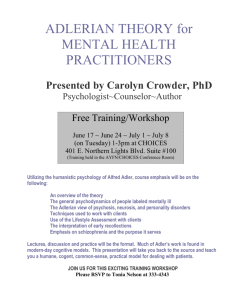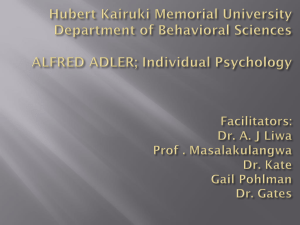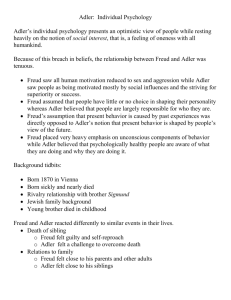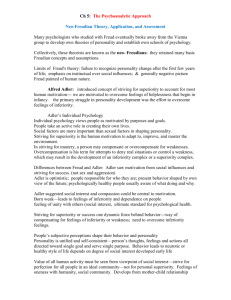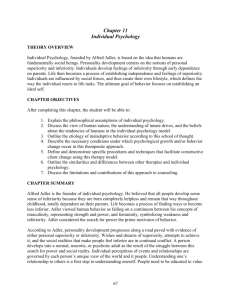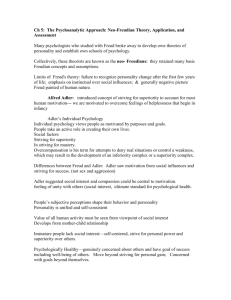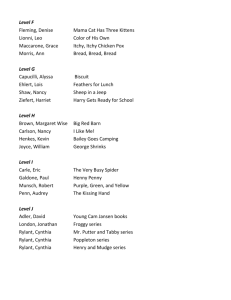Adler: Individual Psychology
advertisement
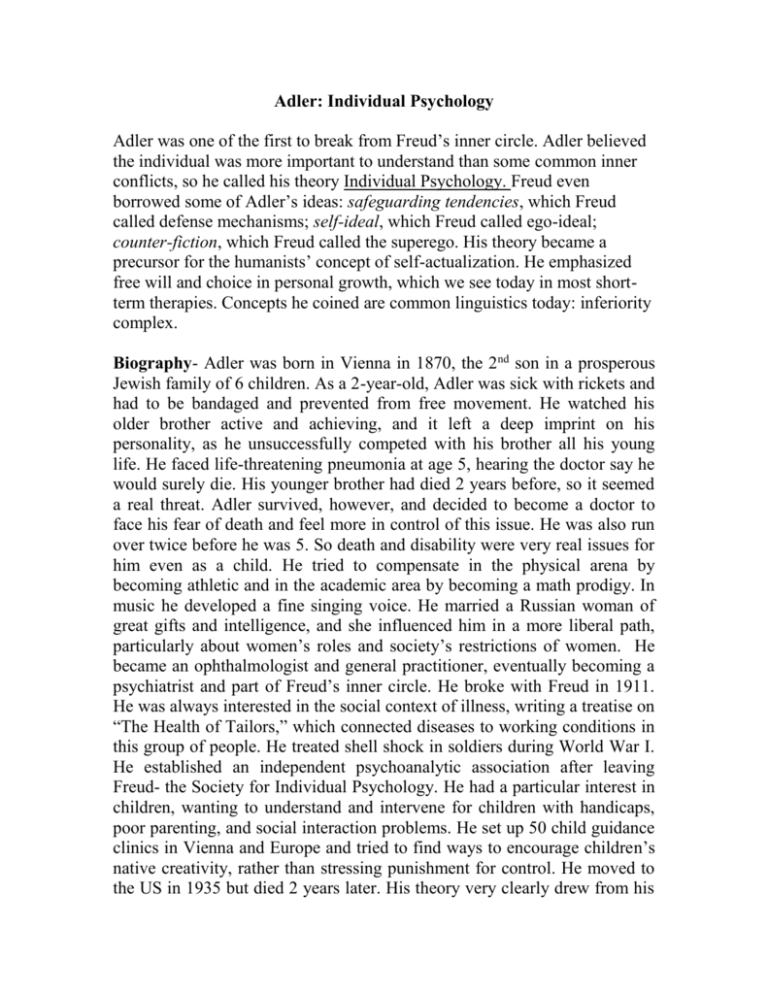
Adler: Individual Psychology Adler was one of the first to break from Freud’s inner circle. Adler believed the individual was more important to understand than some common inner conflicts, so he called his theory Individual Psychology. Freud even borrowed some of Adler’s ideas: safeguarding tendencies, which Freud called defense mechanisms; self-ideal, which Freud called ego-ideal; counter-fiction, which Freud called the superego. His theory became a precursor for the humanists’ concept of self-actualization. He emphasized free will and choice in personal growth, which we see today in most shortterm therapies. Concepts he coined are common linguistics today: inferiority complex. Biography- Adler was born in Vienna in 1870, the 2nd son in a prosperous Jewish family of 6 children. As a 2-year-old, Adler was sick with rickets and had to be bandaged and prevented from free movement. He watched his older brother active and achieving, and it left a deep imprint on his personality, as he unsuccessfully competed with his brother all his young life. He faced life-threatening pneumonia at age 5, hearing the doctor say he would surely die. His younger brother had died 2 years before, so it seemed a real threat. Adler survived, however, and decided to become a doctor to face his fear of death and feel more in control of this issue. He was also run over twice before he was 5. So death and disability were very real issues for him even as a child. He tried to compensate in the physical arena by becoming athletic and in the academic area by becoming a math prodigy. In music he developed a fine singing voice. He married a Russian woman of great gifts and intelligence, and she influenced him in a more liberal path, particularly about women’s roles and society’s restrictions of women. He became an ophthalmologist and general practitioner, eventually becoming a psychiatrist and part of Freud’s inner circle. He broke with Freud in 1911. He was always interested in the social context of illness, writing a treatise on “The Health of Tailors,” which connected diseases to working conditions in this group of people. He treated shell shock in soldiers during World War I. He established an independent psychoanalytic association after leaving Freud- the Society for Individual Psychology. He had a particular interest in children, wanting to understand and intervene for children with handicaps, poor parenting, and social interaction problems. He set up 50 child guidance clinics in Vienna and Europe and tried to find ways to encourage children’s native creativity, rather than stressing punishment for control. He moved to the US in 1935 but died 2 years later. His theory very clearly drew from his own life experiences, as he personally strived to overcome feelings of inferiority early in life. His theory emphasizes conscious striving to improve one’s life. Basic motive is a struggle to move to a better way of life: from Inferiority to Superiority Inferiority – the motive in personality development is to move from a “felt minus” to a “felt plus.” From feelings of inferiority toward superiority, perfection and totality. This is triggered by feelings of inferiority, which are inevitable as an infant and small child. Success means perfection striving- to be one’s best self. Organ inferiority – Adler believed organ inferiority was the source of the felt minus. This may be weak limbs, hearing problems, delayed puberty, even no evident inferiority, but a perceived one. Children compare themselves to peers and try to live up to parents’ expectations for them, and when they think they fail, it produces a sense of inferiority. The environment can heighten or reduce this feeling, depending on how nurturing or demanding it is. The weak organ can also be exploited as an excuse for avoiding life’s tasks and growth. Parents/ teachers can help children learn to overcome their fears of failure. Adler believed when a child made a healthy adjustment, the child strives to compensate for the inferiority (Beethoven who had hearing loss as a child, becoming a great composer, even in his later deafness.) This attempt to compensate directs motivation. If the compensation fails, the person may develop an inferiority complex, an incapacitating feelings of hopelessness that a person cannot overcome his/her handicaps. Aggressive drive is a manifestation of this struggle toward the felt plus- fighting, cruelty, or as athleticism and competitiveness, even politics. Often experienced as anger. Masculine protest is an assertion of manliness that implies greater competence, superiority, and control. Aggressiveness and activity are seen as masculine, as opposed to submissiveness and obedience, seen as feminine. He believed traditional sex roles which subordinated women contributed to masculine protest. He saw this male bias as a weakness of our culture (he’s considered an early feminist for this stand.) Females are motivated by masculine protest when they fight the constraints of the traditional feminine role. They may suffer menstrual problems, problems with pregnancy/ birth, or sexual disorders. Or this could lead women to become career-oriented, marry late or not at all, become lesbian, have no children or become nuns. Superiority striving- by this he meant self-improvement, striving to attain one’s personal best, not trying to best others. Perfection striving- the inherent growth process within the person. A realistic effort to improve, not rigid perfectionism. This is what Rogers & Maslow later called self-actualization. Inferiority complex occurs when the growth process stagnates. The felt-minus situation is too powerful to be overcome and the person accepts exaggerated sense of inferiority. Many of us have feelings of inferiority in a particular area, but it doesn’t stop us from dreaming and trying new things. Only when this feeling hampers all growth is it considered a complex. Superiority complex is a mask for strong feelings of inferiority. It is an exaggerated sense of one’s competence, arrogance, and narcissism. These people are uncomfortable to be around, as they develop behaviors that disturb others. Nations can be afflicted with this complex, resulting in their aggressiveness toward other nations, and discrimination toward other nations, and willingness to separated themselves from the world. Fictional finalism –while Freud saw man as determined by unconscious forces, Adler believed we were the actor in our lives, the causes rather than the effects of life. Personality is creative and allows us choices that determine out outcomes in life. Creative self is trying to discover or create experiences that lead to fulfillment. Creativity is compensatory, overcoming feelings of inferiorityEach person is “the artist of his own personality.” He would suggest in therapy that a person act “as if” he felt confident,etc, until he actually did. Fictional finalism is the desirable future state, the imagined goal that each person imagines. It is unique for each person. It often is a fulfillment of what is lacking in the present: health if one is weak, success if one is poor, love, if one is lonely. Someone with a redeemer complex is trying to save someone, through medicine, ministry, counseling, within a family. So this fictional finalism is a subjective experience, not an objective reality, which directs one’s striving. You cannot understand a person’s behavior unless you understand his/her unique goal. Unhealthy people cannot moderate goals when they are found to be impossible to attain. Unity of Personality is a result of the fictional finalism and unique style of life. Freud believed we were always doomed to inner conflict, but Adler believed this was an artificial division, that the conscious and unconscious worked together to motivate a person toward his desired goal. (Much like Jung’s concept of compensation.) Style of life begins as a compensatory process, to make up for a particular inferiority. It includes concepts about he self, the world, and one’s striving toward a personal goal in the world. Some styles of life are cooperative and hard-working, others are antisocial, narcissistic and aggressive. Style of life is established by age 4-5, so early life experiences are very important in determining personality. First memories are keys to identifying styles of life. Early memories are often flawed, and rarely go back before age 3, as the brain structures responsible for long-term memory are unfinished in development. We know infants have memory- as they interact differently with toys they have played with from toys that are novel to them, but their memories do not last into adulthood. Childhood memories are selective, but first memories stick out because the person has thought about it repeatedly over the years- it represents something important to the person. The facts around the memory are not important as much as the psychological importance or perception of the memory. Children’s memories are influenced by talking with adults, and by the nature of the culture one is raised in. Girls and first born children talk more to adults about their experiences. Some people claim to have memories of their own births or infancy, which are probably fictions, but the emotions associated with the memories are important and revealing psychologically. So memories represent the Story of My Life. This story keeps a person focused on his goal, comforts one when stressed, and prepares him to face the future. Memories are key to style of life. Adler always questioned early memories in a personality analysis. People report them, thinking they aren’t psychologically revealing. Early school memories are clues toward attitudes about achievement and independence. Criminals often report memories of abuse and aggression. Early memories reflect our emotional schemas, expressing ‘relationship paradigms’ that reflect adjustment or pathology. Mistaken and healthy styles of life – Adler believed the person was unique, so he didn’t like typologies, but he did describe 4 types of styles of life in order to teach students. Mistaken styles of life are maladaptive compensations that don’t improve life or have a positive goal for direction. Ruling type seeks to dominate others. They may be selfish, aggressive in order to feel power in place of incompetence. They attack others in a variety of ways, however, such as suicide, drug addiction, as well as aggression. Some may be high achievers, but they are vain and very competitive. They often express superiority over others by putting others down: depreciation complex. Getting type seeks to lean on others, is passive, dependent, rather than active and directed toward goals. They often have depression. Adler said this type had been pampered as a child, and females were more likely to be this type due to the cultural restrictions on women. Even so this neurotic style is subject to change if the person makes other choices. Avoiding type tries not to deal with problems in order to avoid any defeat or embarrassment. Agoraphobia would be a manifestation of this maladaptive style of life. They tend to be isolated, and seem cold in nature. There may be an underlying superiority belief. Whole cultures may embrace this style of life. Healthy Style of life: the socially useful type is adaptive- the person acts to benefit others, not in a sacrificial way, but altruistic and creative ways. They have a well-developed sense of social interest. Later research shows that this style of life is consistent from childhood into adulthood. Development of personality was to some extent a function of circumstances. He believed the restrictive gender roles shaped women in negative ways, that warlike orientations in government shaped ethnic groups, poverty shaped children in negative ways. Family is particularly important in influencing outcomes, particularly siblings. Parental behavior helps or hinders the development of a healthy lifestyle in a child. Parents can set up appropriate learning environments that challenge but don’t overwhelm children. Parents who set their children up to be a reflection of themselves, or to be overly competitive, to be seen as superior to others, will handicap children’s development. Mother particularly influences the development of social feeling, a cooperative attitude that distinguishes the healthy from unhealthy lifestyle. Mothers spend more time with children, so they naturally have deeper influences on their development. Pampered child is overindulged and comes to develop an attitude of entitlement in the world. They are spoiled and face rejection in the world when others do not treat them the way their parents did. Adler thought Freud was a pampered child, which was a severe criticism from Adler. Neglected child may have been orphaned or unwanted or illegitimate or simply parented by people who were uninvolved or impoverished. Neglect leaves children feeling the tasks of life are too overwhelming, and they give up. It can lead a child to desire a pampered style of life, desiring to be cared for and developing dependence on others. Parenting training programs were developed by Adler in order to help solve problems in childhood before they appeared in school and antisocial behavior. Head Start programs have added parenting components and found better outcomes for children, as the parents learn to be more positive, less critical and punitive. The children behave more cooperatively and have better social outcomes. Part of what parents are taught is the goals of children’s behavior: attention-getting, struggle for power or superiority, desire to retaliate or get ever, and display of inadequacy or disability. Family Constellation is the makeup of the family- number, age and sex of siblings. Adler believed siblings had powerful influences on personality. First-born child gets the full attention of the parents, and this child is often pampered or spoiled. Then the oldest is dethroned when the second sibling is born. They don’t cope well with this loss of attention and may become problem children (research doesn’t confirm this assumption.) To compensate for loss of mother’s attention, child turns to the father for attention, or takes on a parental role toward the baby. Oldest children often revere the past, the traditional, longing for the halcyon days before they had to compete for parental attention. They are conservative, authoritative and value structure in many ways. They are often high-achievers in many realms of life. They also tend to burnout at an early age. Second-born child never gets the complete attention of the parents, and always sees the advances the older child has in development- leaving the second child feeling slighted or neglected. This child may be rebellious or revolutionary. The older child is always the pacemaker, stimulating the second child to higher achievement. The second child tries to find an element in which to compete separate from the older child. Youngest child may become problem children because as the baby they tend to grow up spoiled or pampered, without incentive to become independent. If they can find an area in which to excel their prospects are better. Only child never has to compete for parental attention, so may be pampered and overly attached to the mother. Child may develop a ‘mother complex’ and an unrealistic sense of personal worth. Other issues in family environment include if a child is gifted in some way, he won’t directly compete with other sibs, or if a child is handicapped in some difficult way it will be different. Also if the spacing of children is too far apart, they will be like an only child. Research on birth order has shown some relationships, but they are weak. Parents do treat children in different positions differently. Parents are more anxious and critical of the first child than others, giving the first-born more responsibility and pressure to live up to expectations. Like Adler suggested, first-borns do lose the attention of parents when the new baby is born. First-borns are concerned with heritage, more often seeking their genealogical roots. First born develop a knowing style that separates them from others’ ideas, which they challenge and doubt, while later-born children develop a connected knowing- they can take the perspective of others more openly. Second-born aren’t the highest achievers, however, first-borns are. Only children are similar to first-born children- high achievers with high locus of control autonomy, leadership and maturity. Middle children say they are more likely to turn to siblings when stressed, while oldest and youngest children turn to parents. Later-born males seem to have better psychological makeup than males in other positions. Later-born children are rated by peers as more extraverted than older siblings. They are also more trusting and innovative (creative) It is important to examine the quality of relationship among siblings, however, since birth order alone doesn’t tell the whole story. Warm relationships have less influence on personality than adverse and difficult ones. But culture makes a difference. In china, with the one-child policy, only children are spoiled and pampered and develop undesirable social characteristics, dependency and egocentricity due to overindulgence. Sulloway’s analysis of scientific revolutions – this theory suggested that different children develop divergent personalities because each child must strive to compete for parents’ attention in a unique way. So the oldest child may adopt parental standards, but the next child will find another means to stand out. Later-born scientists do seem disposed toward rebellion within their scientific exploration. They are willing to challenge the status quo. There is little research support for this idea, however. Psychological health has to do with developing a sense of community. Social interest is concern for others, using one’s talents to benefit the group rather than selfish goals. The healthier the person is, the more s/he is drawn toward this goal. Social interest can correct for the overemphasis on individualism and competition found in Western culture. Social interest is the innate potential to live cooperatively with other people. It helps us value the common good above personal welfare. Social connections with others enhance growth. Social interest can be compared with empathy- concern for the experience of another person. Empathic people respond emotionally, share the joys and sorrows of others. Even babies cry when they hear other babies cry. This is the basis for all moral development. Without social interest, life seems purposeless and the self feels empty. Ultimately it may contribute to spirituality by encouraging a loving attitude toward all others. This is a core concept in Adlerian theory. All neurosis stems from inadequate social feeling. Schizophrenics show a startling lack of social feeling, lack of empathy, much like criminals. Females show higher social interest and empathy than males. Groups and cultures can be described by social interest or lack thereof. Without a social interest, a group can implode on itself. These cultures glorify war, death penalty, physical punishment, abuse, and fail to provide humane conditions for all classes of people. Healthy social institutions of all sorts teach “Love thy neighbor.” People who score high on social interest score low on narcissism, low on alienation, and low on maladjustment scales. They score high on affiliation, and nurturance. They score higher on self-actualization scales, and develop attitudes toward love that emphasize companionship and reject game playing. These people also are healthier, have more friends, are more satisfied with their jobs. The three tasks in life Work means having a means of earning a living in some socially useful job. Division of labor enables people with differing skills to all share their abilities to benefit the community. Children talking about their job aspirations reveal their style of life. Criminals fail in the work task. Love refers to sexual relationship and marriage, as well as deciding to have children. Adler recommended monogamy as the best solution to the love task, saying premarital sex detracts from the intimate develop of love and marriage. So if someone falls in love and tries to have relationships with 2 people at once, s/he is really trying to avoid the love task. Adler believe sexual dysfunctions or loss of interest in a partner stem from lack of social interest, rather than from purely physical causes. Equality between partners is essential for success in the task of love. He supported women’s right to birth control and abortion, but criticized some women’s decisions not to have children at all. Social interaction refers to the problems of communal life- all our other social relationships. All social relationships should be based on a strong sense of social interest, which prevents narcissism in the relationship. All three tasks are interrelated and none can be solved in isolation. Adler hinted at 2 other life tasks: art, and spirituality. Interventions based on Adler’s theory-Adler didn’t just formulate interventions for individuals, he suggested psychologists should advocate for social change to prevent mental disorders and social problems. School – Adler developed individual education which was an education program that dismantled traditional authoritarian methods and replaced them with practices that fostered social interest. Corporal punishment was ineffective and showed the educator didn’t really care about the child’s growth or problems. Teachers should encourage cooperation among students, talking about misbehavior in the generic with the group and asking the group to suggest alternative behaviors. He recommended peer tutoring for slower learners, clubs for alternative interests, and for teachers to teach the same group of children for numbers of years to be more influential in development. When Adler had 30 Child Guidance Clinics in Vienna, they found that court cases of juvenile delinquency dropped substantially. Therapy aims at changing thinking, emotion, and behavior through stages. He believes all personality failures result from a lack of social interest, so therapy aims to foster social interest, to take over a maternal function. It emphasizes freedom and purposefulness, and gender equity. Therapy has evolved to include family therapy. Style of life is first assessed to provide a context for understanding the problem. Adler would determine what the person’s ultimate goal was, and try to change the person to a healthier lifestyle. Benefits should accrue to others, as well as the patient. Family systems would change when one member would develop greater social interest and less pathology. Dreams were interpreted to indicate style of life- mainly to assess the emotions they create in the person. These emotions are needed to produce change. Adler did not intimidate his clients with advice, but acted like a supportive grandmother. He encouraged patients to accept responsibility for their own life choices and he presented an educational atmosphere, not an authoritarian atmosphere in therapy. He coached patients to develop courage and selfesteem. He believed if a client could change his/her picture or opinion of himself, he could change his life. Adler gently challenged the masks people presented, but he did this supportively. He also believed humor was powerful in therapy. He regarded patients religious beliefs as important, as he thought the idea of God was a reflection of the basic human striving for a better condition. He believed that religious commitments could facilitate growth of social interest and personality. He believed therapy could ease physical symptoms as well as psychological ones. He was a pioneer in the field of psychosomatic medicine, which recognizes psychological components of many illnesses. Recent studies have shown that pessimistic explanatory styles do predict poor health. Optimistic explanatory styles are an indication of Adlerian creative striving. When working with children, he first analyzed the function and purpose of their acting out, in order to set up a mild behavioristic program to shape the behavior and allow the child greater success in achievement. Adler very much influenced the family systems approach to therapy, as well as cognitive therapy, and rationalemotive therapy. He was easily as influential in the field of therapy as Freud.
